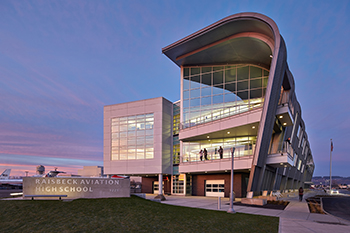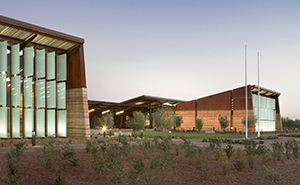AIA Selects 11 Projects for 2014 Design Awards
 WASHINGTON — The American Institute of Architects (AIA) Committee on Architecture for Education (CAE) selected 11 educational and cultural facilities for this year’s CAE Educational Facility Design Awards. The CAE Design Excellence Award honors educational facilities that not only serve as exceptional examples of learning environments, but also further their individual clients’ missions, goals and educational programs. These projects feature responsive and responsible programming, planning and design, while also taking regional and community context into account.
WASHINGTON — The American Institute of Architects (AIA) Committee on Architecture for Education (CAE) selected 11 educational and cultural facilities for this year’s CAE Educational Facility Design Awards. The CAE Design Excellence Award honors educational facilities that not only serve as exceptional examples of learning environments, but also further their individual clients’ missions, goals and educational programs. These projects feature responsive and responsible programming, planning and design, while also taking regional and community context into account.
The 2014 CAE Educational Facility Design Awards jury includes John R. Dale, FAIA (Chair), Harley Ellis Devereaux; Claire Gallagher, Assoc. AIA, Georgian Court University, School of Education; Fred Dust, IDEO; Dutch MacDonald, AIA, MAYA Design; and Marsha Maytum, FAIA, Leddy Maytum Stacy Architects.
2014 CAE Educational Facility Design Award winners:
Baltimore Design School; Baltimore;
Ziger/Snead Architects
The new Baltimore City Public Schools facility combines middle and high school with a focus on fashion, architecture and graphic design. The school was created from an abandoned historic factory building dating back to 1915. The architect transformed the facility in the confines of a minimal budget by using best practices for historic renovation, adaptive reuse, educational design and sustainable design. A driving force in creating the school was the desire to develop creativity and design-informed critical thinking skills for public school students.
Buckingham County Primary & Elementary Schools at the Carter G. Woodson Education Complex; Dillwyn, Va.;
VMDO Architects, P.C.
Two Virginia mid-century schools were transformed into a cutting-edge, holistic learning environment for K-5 students. Evidence-based healthy design principles — integrated into the campus landscape — promote healthy eating, nutrition education, physical activity and well-being as a response to the national childhood obesity epidemic. The K-5 campus includes a teaching kitchen, nutritional displays, open servery, food lab, scratch bakery, dehydrating food composter and student gardens.
Drexel University College of Media Arts and Design (CoMAD) URBN Center; Philadelphia;
MSR (Meyer, Scherer & Rockcastle, Ltd.)
The repurposing of a landmark Venturi, Scott Brown decorated shed provides a new location for Drexel University’s College of Media Arts and Design. The new school brings together different departments into one location, encouraging collaboration across multiple disciplines. The design of the new space focuses on the original “do more with less” concept of the four-story commercial building by creating adaptable spaces for learning.
University of Chicago Child Development Center – Stony Island; Chicago;
Wheeler Kearns Architects
The University of Chicago Child Development Center design does away with primary colors and synthetic play equipment used in most child development facilities. Instead, it offers children an opportunity to discover nature by emphasizing the natural landscape. The facility is centered on two playscapes that have a footprint larger than the building itself. The playscapes conceptually graft onto the historic Frederick Law Olmstead landscape located across the street in Jackson Park. Materials constructed by nature either from the atmosphere (trees, plants, wood) or from the earth (boulders, rocks, sand) dominate.
Wilkes Elementary School; Bainbridge Island, Wash.; Mahlum
The new Wilkes Elementary School was designed around four intimate learning communities that support different styles of teaching and learning. Classrooms are located at the heart and linked on each end, providing a circulation pattern that prevents both the feeling and effect of isolation. The design also creates opportunities for variation in scales of learning from multi-classroom gatherings to intimate individual experiences.
Central Arizona College, Maricopa Campus; Maricopa, Ariz.; SmithGroupJJR
The creative, wide-ranging design of the new campus promotes cross-disciplinary learning and provides a model for arid-region sustainable development.  The plan, called the Genome Project, creates a complete genetic blueprint for the new campus that promotes collaboration as well as celebrates local heritage and vernacular.
The plan, called the Genome Project, creates a complete genetic blueprint for the new campus that promotes collaboration as well as celebrates local heritage and vernacular.
Coastline Community College, Newport Beach Campus; Newport Beach, Calif.;
LPA Inc.
The new interdisciplinary, 66,800-square-foot Newport Beach Campus of Coastline Community College includes sustainability features such as stormwater management, natural ventilation, green roofs, living walls, maximized daylight and views of the ocean. The project was designed to achieve LEED Gold rating and exceeds the California Title 24 energy code by 33 percent.
James B. Hunt Jr. Library at North Carolina State University; Raleigh, N.C.;
Architect: Clark Nexsen, Associated Firm: Snohetta
Large open spaces connect all floors of the library, and staircases are emphasized to ensure an interactive and social environment between more focused study areas. Designed to achieve LEED Silver, the building features abundant natural light and expansive views of the nearby lake. Fritted glass and a fixed external aluminum shading system help diminish heat gain and maximize views and ambient natural light.
Nathan Hale High School Modernization; Seattle;
Mahlum
Nathan Hale is a progressive, public high school known for its collaborative, presentation-based curriculum and strong community connection. This facility modernization and addition to the 1960’s structure creates a flexible teaching facility that unites the campus community. Light-filled halls and classrooms, as well as the building transparency, express the school’s values while creating a healthy environment.
PAVE Academy Charter School; Brooklyn, N.Y.;
Mitchell | Giurgola Architects, LLP
PAVE Academy is a 450-seat, K-8 public charter school located on an isolated corner lot in the Red Hook section of Brooklyn. The PAVE leadership team’s goals included creating a community-friendly school that would support significant parent involvement and the needs of a particularly high-needs population living in poverty. Children arrive early for a quiet breakfast and stay well into the afternoon with learning and play to fill a void many face at home.
Raisbeck Aviation High School; Tukwila, Wash.;
Bassetti Architects
Raisbeck Aviation High School was created because of Highline School District’s proximity to the aviation industry in conjunction with the school’s desire to give students access to college and engineering professions. The new 400-student STEM (Science, Technology, Engineering, and Math) school enables students to learn through co-location with the Museum of Flight and immersion in aerospace and aviation. The design supports this program physically, visually and symbolically with project labs for aircraft and robotics construction, state-of-the-art science labs, classrooms and a multi-purpose gathering space.
